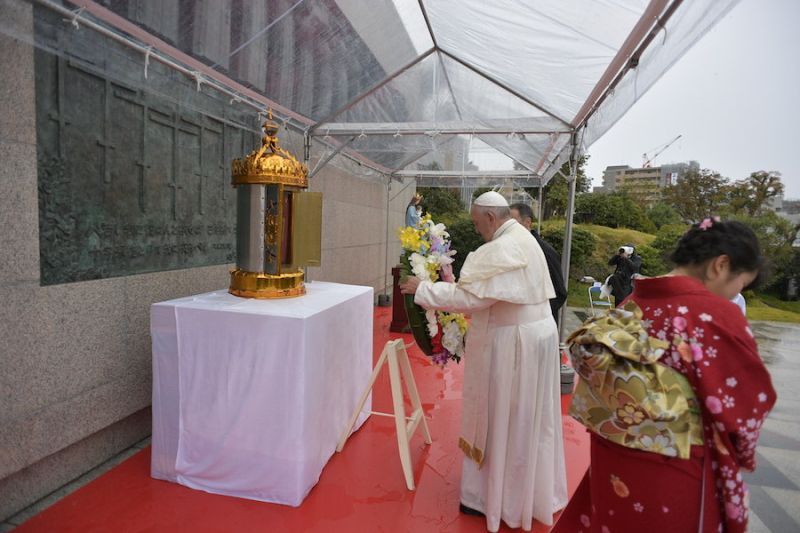
ACI Prensa Staff, Feb 5, 2024 / 15:40 pm (CNA).
In the 16th century, a young Franciscan friar from Mexico was blown off course en route back to his homeland from the Philippines, landing on the shores of Japan. San Felipe de Jesus — St. Philip of Jesus — is now celebrated Feb. 5 in the Church for his martyr’s witness given on that island.
Felipe de las Casas Ruiz was born on May 1, 1572, in Mexico City to Alonso de las Casas and Doña Antonia Ruiz Martínez, who both emigrated from Spain in 1571 to the viceroyalty of New Spain (Mexico) shortly after their marriage.
Legend says that Felipe was naughty as a child and that his parents hired a nanny to take care of him. But by all accounts, the young boy just had a restless and curious spirit with a drive to be active and seek adventure.
In the family’s orchard was a withered fig tree and one day, the story goes, Felipe did something that made his nanny very angry, causing her to exclaim sarcastically: “Holy Philip? Yes, when the fig tree comes back to life!” Curiously, several testimonies collected for Felipe’s cause pointed out that on the day of his death, the fig tree in his father’s house became green.
While still a teenager, perhaps inspired by the adventurous spirit of the missionary friars, Felipe applied to the Franciscan novitiate (Order of Friars Minor), but once there, he could not tolerate the austerity and severity of the rules of the monastery. So he left and returned to his parents’ house. After that, he worked for a few years as a silversmith, but the earnings were meager, so his father sent him to the Philippines to pursue his fortune.
Felipe arrived in the city of Manila and found its lively atmosphere, riches, and pleasures to be seductive. Soon, however, anguish, emptiness, and meaninglessness began to strike his heart constantly. What used to seem pleasant or entertaining became painful and embarrassing. The young man heard once again the call of Christ: “If you want to come after me, renounce yourself, take up your cross and follow me” (Mt 16:24).
Once again, Felipe knocked at the door of the Franciscans — this time in Manila, where he was received and where his conversion process really began. Surrendered to prayer, studies, and the exercise of charity, he came to know a completely different world, one that filled his heart with joy.
He took the name of Felipe de Jesus, with which he would be incorporated into the order. Now, at last, he was surrounded by real brothers: the needy, the sick, and, of course, the Franciscan friars.
One day, Felipe received a special announcement. His superiors informed him that he would be ordained a priest and that it would take place in his hometown in Mexico. Together with Friar Juan Pobre and other Franciscans, he set sail for New Spain, but a great storm diverted the ship to the coast of Japan, where Friar Pedro Bautista and other Franciscan friars were already doing arduous evangelizing work.
Felipe was not disheartened by the unforeseen event and thought that it could be a powerful opportunity to strengthen his “yes” to the Lord. So he set out to evangelize and his efforts quickly bore fruit, which filled him with encouragement. Unfortunately, however, the local authorities and nobility began to take a dim view of the growing number of conversions among the island’s natives, and many viewed the missionaries with suspicion.
Soon a persecution ordered by the Toyotomi Hideyoshi, the de facto leader of Japan at the time, would break out against the Franciscans, Jesuits, and other Christians. Hideyoshi feared that the foreign presence would jeopardize his political ambitions and commercial interests. Many laypeople and religious were imprisoned and condemned to death. Felipe, who was not yet a priest and enjoyed the status of a castaway, could have avoided imprisonment and torments, but he rejected the possibility of leaving and chose to stay and die with the other Franciscan missionaries who lived there.
On Feb. 5, 1597, the friar was forced, with other Franciscans, Jesuits, and laypeople, to make a walk through towns and villages as a form of public mockery. He, like the rest of the future martyrs, had one of his ears cut off. The group consisted of 26 men.
Finally, they arrived in Nagasaki and were taken to Mount Nishizaka, where they were crucified. Felipe of Jesus was hung on a cross by his wrists and neck, using rings. The one they put around his neck exerted such pressure that Felipe began to suffocate. As he ran out of air and his strength was drained, he kept repeating “Jesus, Jesus, Jesus.” After a while, two executioners approached him and plunged their spears into his body. He was the first of the group to die. He was 25 years old.
Felipe of Jesus was beatified, along with his companions in martyrdom, on Sept. 14, 1627, and canonized on June 8, 1862.
Between 1958 and 1962, the architectural complex of Nishizaka Park was built in Nagasaki in the place where the 26 martyrs perished. The complex is run by St. Philip of Jesus Church and there is a museum next door that commemorates the life and death of these courageous martyrs.
San Felipe de Jesús is the patron saint of Mexico City.
This article was first published by ACI Prensa, CNA’s Spanish-language news partner. It has been translated and adapted by CNA.
If you value the news and views Catholic World Report provides, please consider donating to support our efforts. Your contribution will help us continue to make CWR available to all readers worldwide for free, without a subscription. Thank you for your generosity!
Click here for more information on donating to CWR. Click here to sign up for our newsletter.





Leave a Reply